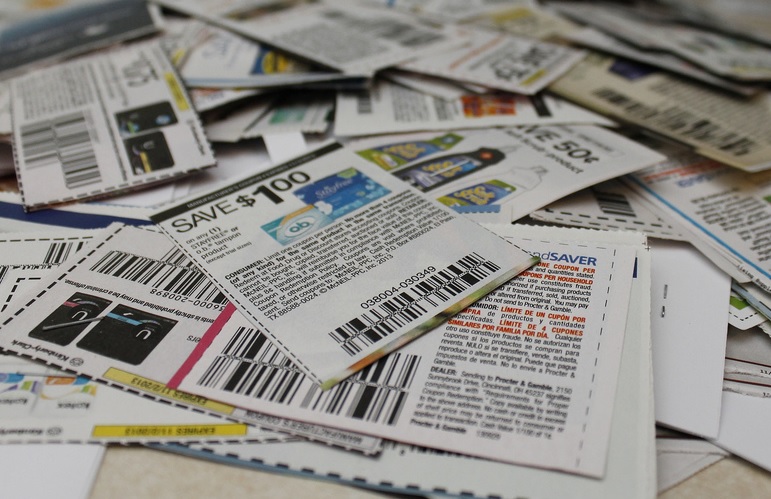
If you feel like you’re using fewer coupons than you used to, you’re probably right. In fact, you’re probably using even fewer coupons than your grandmother did.
According to newly-released figures from Inmar’s annual Promotion Industry Analysis, coupon use plummeted to a historic low last year. Out of 321 billion coupons distributed in 2015, only 2.5 billion were redeemed – down a whopping 13% from 2014.
It’s the lowest redemption figure since Inmar began compiling annual statistics three decades ago. You have to dig through historical data compiled by NCH Marketing’s predecessor Nielsen Coupon Clearing House, to find that the last time a mere 2.5 billion coupons were redeemed was way back in 1976 – when only about 40 billion coupons were issued, newspaper coupon inserts were in their infancy, and no one had ever heard of “extreme couponing.”
So what’s going on? Are we in the midst of a couponing crisis? Are coupons on their way to extinction? Or do manufacturers have the redemption rate right where they want it? There are several reasons why coupon use is down – and why the industry isn’t necessarily alarmed by it:
Coupons Aren’t That Great
The less attractive a coupon is, the less likely you’ll want to use it. Echoing an earlier Kantar Media report, Inmar found that coupons continue to get less valuable, and have more restrictions.
The average face value of all coupons last year was $1.68, down 2.3% from 2014. The average purchase requirement was 1.45 items, up 1.2%. The average expiration date was 2 months away, down 4.3%. And despite shoppers’ preference for food coupons, an overwhelming 62.9% of all coupons were for nonfood items.
Unhappy Couponers
Compare those figures to what couponers say they want, and you end up with some unhappy couponers. Nearly half of those surveyed by Inmar said there are too many rules and exclusions for using coupons, half said they usually won’t use a coupon if it requires them to buy multiple items, and almost two-thirds complained that their coupons often expire before they have a chance to use them.
That dissatisfaction, combined with a slowly improving economy and falling gas prices, means some shoppers simply aren’t bothering with coupons anymore. 62% said “I can’t find coupons for products I want to buy,” up from 53% two years prior. And 42% said “it takes too much time to find coupons” they want to use, up from 30%.
Still, the quality of coupons is only part of the reason for the falling redemption rate. There are some more intriguing factors that could play into the sharp decline:
Paper Is Becoming Passé
An increasing number of shoppers prefer digital offers. And if they can’t find digital coupons they want to use, they won’t use coupons at all.
“There is growing disinterest in using traditional vehicles to find and acquire promotions,” Devora Rogers, Inmar’s Senior Director, Marketing told Coupons in the News. “Shoppers are demanding even greater convenience in their acquisition of coupons and are expecting promotions to be delivered to them that closely align with their lifestyles and media preferences.”
Inmar found that shoppers are expressing “less desire to work for deals,” and want more personalized offers and automatic discounts. 62% of those surveyed said “I want coupons sent to my mobile phone for products that I normally buy.” And nearly half said “I wish all coupons were digital.”
It’s worth noting that digital coupons typically can only be used once, on a single item, compared to the fistfuls of identical paper coupons that some couponers might redeem. So that could account for some of the decline in the number of coupons used. Plus, fewer people even use fistfuls of paper coupons anymore, because fewer people than ever are subscribing to their local newspaper. Newspaper insert coupons still made up 89.1% of all the coupons distributed last year, but only 38.4% of those redeemed. Fewer papers sold, means fewer of those billions of insert coupons are getting into the hands of those who might use them.
Changing Habits
More shoppers are buying their groceries online, or ordering them online and picking them up at the store. And most online grocery services don’t accept coupons. That means, as more shoppers shift to online grocery shopping, more of them are shifting away from using coupons.
And our tastes are changing, too. More shoppers are eating healthier, turning away from packaged, processed foods that offer coupons, in favor of produce and prepared foods, few of which offer coupons at all.
“The coupon redemption trends we’re seeing indicate that the strategies currently deployed are not yet aligning with consumer demand and media use, leaving shoppers unable to find coupons for the products they want to buy,” Inmar Chairman & CEO David Mounts said in a statement.
What Next?
Back in 1992, coupon use reached an all-time high of 7.9 billion redemptions. With current-day usage less than a third of that amount, we may never reach those heights again.
But there’s still plenty of reason to believe that coupons aren’t about to fade away. Even if we’re not using as many coupons as we used to, consumers still like them. 92% of the shoppers surveyed by Inmar said they’ve used at least one coupon in the past few months, and 48% said they use them regularly. “Shoppers are still using – and will continue to use – coupons on a regular basis as a central savings strategy,” Rogers said.
So if coupons catch up with our shifting shopping habits, more of us may happily get back into the habit of using them. We may not end up couponing like it’s 1992 again. But if coupons get better, we can at least settle for couponing like it’s 1977.











Pingback: Will Brand Advertising Dim Digital Star: The Long and Short of It
Go digital! Star Cloud Services can deliver COLOR digital receipts directly from the POS printer to the shoppers APP.
I guess they don’t count card-specific coupons, such as the Just4U from Safeway and also many other grocery stores. That’s really the only way I use coupons now.
The quoted stats:
The average face value of all coupons last year was $1.68, down 2.3% from 2014. The average purchase requirement was 1.45 items, up 1.2%. The average expiration date was 2 months away, down 4.3%.
seems grossly misleading. Sure, there are plenty of $2 off coupons, but you have to buy 2 or 3 items to use a SINGLE coupon. Or silly things like “buy two of X, get Y for free”.
They have made them more complicated, folks just throw up their arms in disgust. Or the minimal amounts. Really, 25 cents on a $6 package of paper towels? Anything sub-50-cents is rarely worth the effort, even when you try to match sales, store coupons, and manufacturer coupons.
To clarify – yes, MFR offers published through a platform like Safeway’s J4U program *are* included in Inmar’s trends data.
Trade funds do not require transaction settlement, so they’re not included in Inmar data. It’s not misleading, it’s just… complicated.
And last but not least – Average Face Value isn’t a misleading stat; if you want to know the per-unit discount, Inmar publishes that too… (it just wasn’t covered in the topline Trends findings)
Some of the coupons are not worth cutting out they are suppose to save you money. The ones in the paper are getting terrible I mean .25 cents is .25 cents but when the product is already costly it is not worth it.
You won’t usually hear it in a trends webinar, but 20 years of redemption decline might also have something to do with coupons being used more as a tool for CPGs to leverage and negotiate with their retail trading partners than actually driving redemption volume or delivering discounts to shoppers.
Just sayin’.